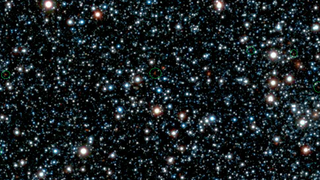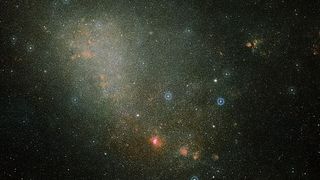New 3D cosmic map reveals 1 million previously hidden galaxies

Astronomers have created the largest ever 3D map of 1 million distant galaxies otherwise obscured by the Milky Way's dwarf galaxy neighbors, the Magellanic Clouds.
The Magellanic Clouds are irregularly shaped galaxies that are a stunning feature of the Southern Hemisphere sky, visible to the naked eye. But the brightness of these dwarf galaxies coupled with the fact that they take up a large area of the night sky means that the Milky Way's neighbors block our view of many much more distant galaxies. So when astronomers are observing the billions of galaxies in the universe, they tend to avoid this part of the sky.
"The Magellanic Clouds are beautiful galactic companions, but they, unfortunately, do block part of our view of objects further out," University of Keele astronomer and a member of the map-building team, Jessica Craig, said in a statement. "Our work is helping overcome that, and in the process helping to fill in the gaps in our map of the universe."
Related: Gorgeous Hubble Space Telescope image shows turquoise waves rippling through Milky Way companion
Craig and her colleagues tackled this problem by photographing the Magellanic Clouds in such high definition that they could look through the gaps between the stars that make up these galaxies. To make these images, the team turned to the Visible and Infrared Survey Telescope for Astronomy (VISTA)based at Paranal Observatory in Chile.
But these increasingly distant "hidden" galaxies are particularly difficult to see because they appear fainter and redder than they are due to dust in the Magellanic Clouds. To account for this effect, the team turned to a radio telescope, the Galactic Australian Square Kilometer Array Pathfinder Survey (GASKAP), that can peer through the dust between Earth and distant galaxies. The GASKAP data allowed the scientists to create a detailed map of gas and dust in the Magellanic Clouds and thus account for the amount of 'reddening' these factors cause to the galaxies they obscure.

Due to the sheer number of light sources in the images of the Magellanic Clouds, the human eye alone can't distinguish distant galaxies from closer objects. But stars shift in position while distant galaxies remain in the same place, so the team was able to use data from the star-mapping Gaia observatory to properly categorize each light source.
Get the Space.com Newsletter
Breaking space news, the latest updates on rocket launches, skywatching events and more!
The astronomers used a second technique to confirm the distinction between distant galaxies and relatively nearby stars. Because the universe is expanding as distant galaxies move away from Earth, the wavelength of light from these galaxies is stretched. Longer wavelengths of visible light are red, so astronomers dub this lengthening redshift.
The more distant an object the more rapidly it recedes, and thus the redder its light appears, so distant galaxies are redder than stars. By factoring in color, the team could further eliminate stars from their data.
Finally, the astronomers applied machine learning and artificial intelligence to order the galaxies and create a 3D map of an estimated 1 million galaxies.
Craig presented the team's findings in mid-July at the National Astronomy Meeting held at the University of Warwick in the U.K.
Follow us on Twitter @Spacedotcom and on Facebook.
Join our Space Forums to keep talking space on the latest missions, night sky and more! And if you have a news tip, correction or comment, let us know at: community@space.com.

Robert Lea is a science journalist in the U.K. whose articles have been published in Physics World, New Scientist, Astronomy Magazine, All About Space, Newsweek and ZME Science. He also writes about science communication for Elsevier and the European Journal of Physics. Rob holds a bachelor of science degree in physics and astronomy from the U.K.’s Open University. Follow him on Twitter @sciencef1rst.
